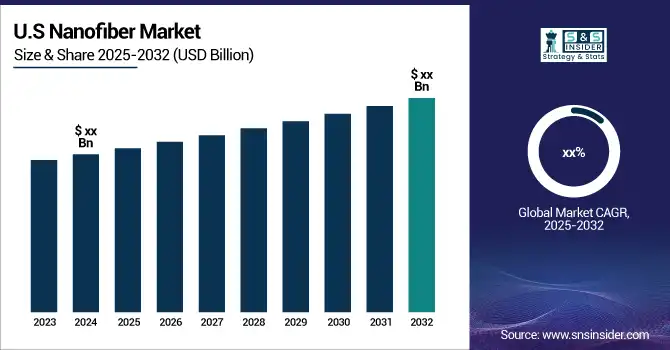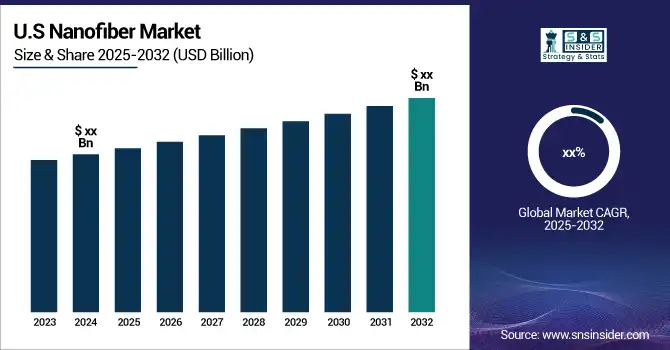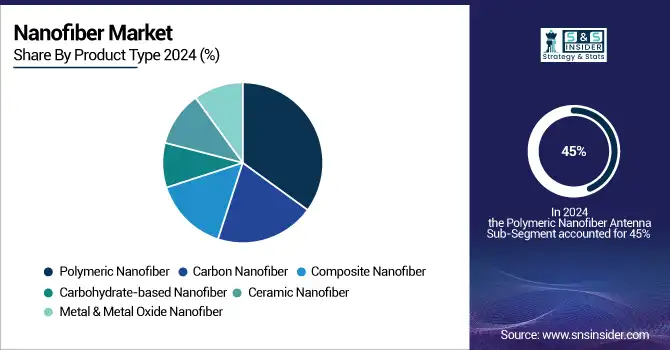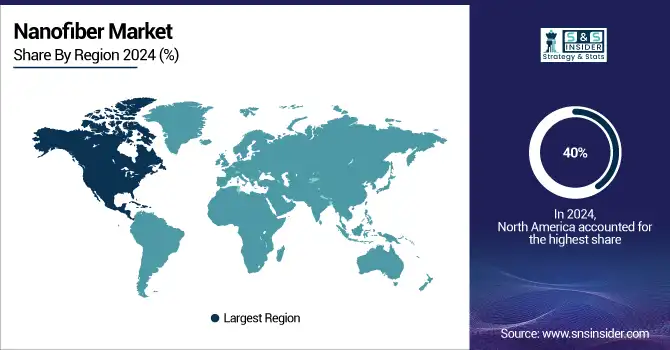Nanofiber Market Report Scope & Overview:
The Nanofiber Market Size was valued at USD 1.10 billion in 2024 and is expected to reach USD 5.3 billion by 2032 and grow at a CAGR of 21.80% over the forecast period 2025-2032.
The nanofiber market is experiencing rapid growth, mainly due to increased medical, environmental, and energy usage. The most significant factors driving the growth in this market are ongoing innovation in manufacturing techniques and the application of nanofibers. Nanoscience Instruments has significantly added value to innovative processes regarding advanced nanofiber productions, emphasizing scalability and precision. Their inventions are aiding various industries to fabricate nanofibers in their products, namely in air filters, protective clothing, and battery separators, with continuous and large-scale production.

Get more information on Nanofiber Market - Request Sample Report
The discovery of nanofibers is proving to be an absolute game-changer in discovering upgraded solutions across various sectors. Especially in the medical field, nanofibers are showing spectacular innovations. In February 2024, Cornell University researchers showcased nanofiber-based bandages that fight infections and aid in faster recovery from wounds. The drug delivery and moisture control shown by the bandages are due to the particular structure of nanofibers; these bandages can be very effective for healing wounds. It has been a breakthrough that reflects the increasing role of nanofibers in advanced healthcare solutions such as tissue engineering, drug delivery systems, and artificial organs. Nanofiber technology is being broadly applied in the healthcare sector and will show significant growth in the market for the next few years with exponential growth.

Market Size and Forecast:
-
Market Size in 2024: USD 1.10 Billion
-
Market Size by 2032: USD 5.38 Billion
-
CAGR: 21.8% from 2025 to 2032
-
Base Year: 2024
-
Forecast Period: 2025–2032
-
Historical Data: 2021–2023
Key Nanofiber Market Trends
-
The demand for nanofibers in air and water filtration systems is rapidly increasing due to stricter environmental and health regulations.
-
Healthcare and biomedical applications such as wound dressings, tissue engineering, and drug delivery are driving strong adoption.
-
Nanofibers are gaining traction in energy storage and electronics, including batteries, sensors, and supercapacitors.
-
There is a clear market shift toward eco-friendly and biodegradable nanofiber materials.
-
Electrospinning and alternative production methods are advancing to improve scalability and reduce costs.
-
The market is witnessing growth in smart textiles and protective fabrics with enhanced functionalities.
-
Asia-Pacific remains the fastest-growing region, supported by industrialization and large-scale R&D initiatives.
Nanofiber Market Growth Drivers
-
Increasing Demand for Nanofibers in Advanced Medical Applications Driving Market Growth
Advanced medical applications of nanofibers are an emerging aspect of market growth. Nanofibers that possess unique properties such as a high surface-area-to-volume ratio, biocompatibility, and excellent mechanical properties are now becoming an integral part of many medical applications. These include drug delivery systems, tissue engineering, and wound healing, for which nanofibers can successfully enhance the outcomes of the treatment. For example, Cornell University has developed a nanofiber-based bandage introduced in February 2024. Such a bandage can accelerate healing and avoid infections at the site of wounds. It is an example of how nanofibers are reshaping medical treatments by making medical products effective. Moreover, the fact that individuals in the developed world are living longer, creating an aging problem, and most such people suffer from chronic diseases, makes it imperative to have more efficient and effective medical treatments. This situation makes nanofiber-based products an ideal solution. They can enhance the absorption of drugs, increase healing rates, and improve recovery for patients, thus raising their demand in the healthcare sector. Further, the rising research on nanofibres for medicine and medical applications will raise its demand manifold in the future.
-
Environmental Sustainability Pushing the Demand for Cellulose Nanofibers Across Industries
A worldwide necessity for environmental sustainability mainly increases the demand for nanofibers, especially cellulose nanofibers. To cater to this emerging trend of de-layering away from traditional petroleum-based products, cellulose nanofibers have been gaining wide acceptance as an environmentally friendly alternative because of their biodegradability along with their excellent mechanical strength. Packaging, automotive components, as well as textiles, are increasingly integrated with these fibers. In October 2022, Japan's Forestry and Forest Products Research Institute successfully demonstrated that cellulose nanofibers may be a potential replacement for petroleum-based plastics; this can help reduce the plastic waste nagging the globe. This is in line with the global aspects moving towards a circular economy whereby industries are challenged to adopt environmentally friendly materials to reduce the carbon footprint. Because of their ability to biodegrade naturally, while possessing very high mechanical strength, cellulose nanofibers can be integrated into packaging materials, automotive parts, and even electronics. The demand for eco-friendly materials in all industries is likely to continue to propel the market forward as environmental regulations are enforced, holding significant opportunities for nanofiber producers.
Nanofiber Market Restraints
-
High Production Costs and Technological Complexities Restraining the Broader Adoption of Nanofibers
Major restraint to nanofibers market production cost and technological complexity of manufacturing the nanofibers. The production of nanofibers, especially through electrospinning, is technologically demanding and relies greatly on the equipment, the professional operators, and the amount of control over the parameters of production, which makes it relatively expensive and difficult to scale. Even though firms like Mecc Co., Ltd. have experienced great success in fine-tuning electrospinning technology to efficiency and cost-effectiveness, the facts are that making nanofibers, on a big scale and low price, is not easy. In many cases, the production process is labor-intensive and requires certain equipment that can inflate the overall costs to make the products not competitive with price-sensitive markets. This is highly evident in industries such as packaging or textiles, where cost must be minimized. The challenge of maintaining large-scale production without a deviation in quality further heightens the complexity. All these factors are put together to limit the wide-scale usage of nanofibers, more critically where substantial cost reduction is required in the industry. Overcoming the cost and complexity problems will play a key role in unlocking their wider market potential in any industry.
Nanofiber Market Opportunities
-
Expanding Use of Nanofibers in Energy Storage Systems Offering Market Growth Opportunities
The growing applications of nanofibers in the energy storage field open immense prospects for future market growth. Nanofibers have great electrical conductivity, large surface areas, and mechanical strength, hence widely applied in advanced batteries, supercapacitors, and fuel cells. They can better energy storage devices through enhancement of ionic transport along with increased charge storage capacity, hence finding demand in the renewable energy sector. The incorporation of energy storage technologies becomes all the more crucial with a sharp swing towards clean energy and a halt in fossil fuel consumption. Nanofibers play a pivotal role herein as they assist in the practical applications of more energy-efficient and longer-lasting energy storage technologies. Renewable energy projects have been exponentially invested in by governments and industries. However, this upsurge has progressively increased the demand for high-end energy storage technologies. Improvements in the efficiency and lifespan of these systems create opportunities for growth for those companies specializing in producing nanofibers with specific energy applications. Nanofiber technologies are bound to be well placed in the development of the growing renewable energy market.
Nanofiber Market Challenge
-
Scaling Up Nanofiber Production Without Quality Loss Remains a Significant Market Challenge
Scaling up mass production for nanofibers represents probably one of the biggest challenges in this market. Nanofibers are being used in some applications for healthcare use and energy storage purposes in areas where uniform diameter, high strength, and controlled porosity exist. Thus, electrospinning has thus far proven to be difficult to take from the scale used in the laboratory over to industrial manufacturing. The major challenge in mass-producing nanofibers is ensuring the quality and precision of the nanofibers. Although Nanoscience Instruments is improving the scaling up of nanofiber production technology, the problem cannot be easily solved. The sensitivity of nanofiber production to environmental and process parameters is very high, and small changes in such conditions can lead to defects in the final product that jeopardize its functionality in a critical application. Overcoming such scaling issues will be necessary for the widespread commercialization of nanofibers. In the meantime, bottlenecks to meet the surging demands from various industries may emerge in the market.
Nanofiber Market Segment Analysis
By Product Type
In 2024, the Polymeric Nanofiber segment dominated the Nanofiber Market, with a share of about 45%. The polymeric nanofiber segment is dominated by polymeric nanofibers in the global nanofiber market mainly because of the versatility and wide-ranging application in healthcare, textiles, filtration, and other industries. PVA and polystyrene nanofibers are popularly preferred due to ease of production, low cost, and tunability. Polymer nanofibers are finding increased applications in wound dressings and drug delivery in the health sector because of their biocompatibility and hence a significant improvement in healing. Companies like Elmarco are also improving the methods of producing polymeric nanofibers that are suitable for high-performance applications, further solidifying their position on the market. The highly dominant share of the nanofiber market in years to come is likely to be maintained owing to superior characteristics and varied uses.

By Technology
In 2024, the Electro Spinning segment dominated and accounted for around 60% of the Nanofiber Market. This is because of the importance of this technology: it's capable of producing nanofibers having a high aspect ratio and uniform diameters, making them applicable in many applications from filtration to tissue engineering and drug delivery systems. Electrospinning is preferred since it includes a relatively easy setup, and is scalable, which enables mass production without a significant reduction in quality. Thus, companies like Nanofiber Solutions employed electrospinning to generate nanofiber membranes for air as well as water filtration that prove effective in this method toward obtaining efficient filtration along with pollution removal. The ability to produce a wide variety of nanofiber materials further supports the strong position in the market of electrospinning: from polymers to ceramic fibers and even composites tailored for specific applications, maintaining its leadership in the field of nanofibers.
By End-use Industry
In 2024, the Medical segment dominated the Nanofiber Market with a market share of approximately 35%, mainly due to growth in demand for advanced medical applications, such as wound dressings, drug delivery systems, and tissue engineering scaffolds. Nanofibers prepared from a biocompatible material can offer unique properties, presenting a high surface area and porosity that can maximize the efficiency of healing and improve drug absorption. For example, nanofiber-based wound dressings have emerged with the potential that enhance healing that is designed to avoid infection, and the same trend is shown by some of the well-known medical institutions in their research. Similarly, companies such as Ahlstrom-Munksjö are actively involved in the production of regulatory-grade nanofiber material, which is an obvious addition to the growth of the medical segment. Continued research in nanotechnology, along with the increasing focus placed on improving healthcare outcomes, will continue to propel the medical segment to dominance in the nanofiber market in the coming years.
Nanofiber Market Regional Analysis
North America Nanofiber Market Insights
North America dominated the Nanofiber Market in 2024 with about 40% of market share. This is due to this region's heavy investment in research and development, advanced health infrastructure, and high demand for innovative solutions across all industries. The region houses most key players and research bodies specializing in nanofibers for use in medical devices, filtration, and textiles. For example, Ahlstrom-Munksjö and Freudenberg Group are companies providing nanofiber technology for developing advanced filtration materials and medical solutions. Strong regulatory frameworks introduced by the region and increasing collaboration of academia and industry further enhance the market position of the region, resulting in an uninterrupted flow of innovations in nanofiber technologies.

Get Customized Report as per your Business Requirement - Request For Customized Report
Asia Pacific Nanofiber Market Insights
However, the Asia-Pacific region emerged as the fastest growing region in 2023 with a projected CAGR of 15% over the next few years. This, again, will be further supported by the fast industrialization rising urbanization, and increasing demand for high-performance materials in countries such as China, India, and Japan. There is huge investment happening across the lines of textiles, automotive, and healthcare industries that have nanofibers as fast-growing applications in these fields. For instance, Indian textile industries are now embracing nanofibers with increasingly innumerable applications for the production of light-textured breathable fabrics, which have water-resistant and antimicrobial properties. Of course, governmental initiatives towards sustainability and innovativeness leading to productivity and marketability are moving acceptance in various applications in the region, thus making the Asia-Pacific region a growth hotspot in the nanofiber market.
Europe Nanofiber Market Insights
Europe continues to demonstrate strong growth in the nanofiber market in 2024, driven by advanced applications in healthcare, filtration, and energy storage technologies. The region’s focus on sustainability and biodegradable nanofibers aligns with stringent EU regulations on eco-friendly materials, fostering innovation in bio-based nanofiber production. Leading R&D initiatives across Germany, France, and the U.K. are accelerating commercialization, while the automotive and electronics sectors further stimulate demand for high-performance nanofiber solutions.
Latin America (LATAM) Nanofiber Market Insights
The LATAM nanofiber market is gradually expanding, supported by growing adoption in water treatment, healthcare, and packaging applications. Countries like Brazil and Mexico are seeing increased investments in filtration technologies to address water quality challenges, driving nanofiber uptake. The region’s emphasis on sustainable materials and its developing biomedical sector are also creating growth opportunities, though high production costs and limited local manufacturing remain barriers to large-scale adoption.
Middle East & Africa (MEA) Nanofiber Market Insights
In MEA, the nanofiber market is gaining traction primarily through applications in air and water filtration, oil & gas, and protective textiles. Rising demand for clean water technologies and strict air quality regulations in the Gulf states are supporting market growth. Additionally, governments are investing in healthcare infrastructure and renewable energy projects, creating opportunities for nanofiber use in biomedical devices and energy storage. However, limited R&D facilities and high dependency on imports continue to restrain faster regional expansion.
Nanofiber Market Competitive Landscape
RadiantGraph
The University of Maine
The University of Maine is a leading U.S.-based research institution recognized for innovations in sustainable materials and nanotechnology.
-
In July 2024, researchers at the university engineered a new dewatering process for cellulose nanofibers, enhancing drying rates to improve efficiency and reduce production costs, thereby strengthening the sustainability of cellulose-based materials.
Cellevate
Cellevate is a biotechnology company focused on nanofiber-based innovations for advanced therapeutic applications.
-
In March 2024, Cellevate announced the pre-launch of its microcarrier nanofiber for gene therapy at CPhI Milan, aimed at improving cell culturing and genetic material delivery, reinforcing its commitment to the development of next-generation therapeutic solutions.
Nanofiber Market Key Players
-
Ahlstrom (Ahlstrom-Munksjö filter media, medical nonwovens)
-
Asahi Kasei Corporation (Asahi Kasei nanofiber membrane, Bemberg nonwoven fabric)
-
Donaldson Company, Inc. (Ultra-Web nanofiber filtration media, Donaldson Torit dust collectors)
-
DuPont (DuPont Tyvek, DuPont Sorona)
-
Elmarco Ltd. (NanoSpider nanofiber production technology, nanofiber nonwovens)
-
eSpin Technologies Inc. (eSpin nanofiber mats, eSpin filtration products)
-
Hollingsworth & Vose Company (HVF nanofiber filter media, high-performance battery separators)
-
Nanofiber Solutions (Nanofiber membranes, filtration media)
-
Nanofiber Technology Inc. (Nanofiber textiles, nanofiber air filters)
-
Nippon Paper Industries Co. Ltd (Nanofiber cellulose products, specialty paper)
-
Omya AG (Omya fiber-reinforced composites, Omya nano calcium carbonate)
-
PECOFacet (Facet nanofiber filters, PECO filtration solutions)
-
Polymicro Technologies (Polymicro fiber optic cables, nanofiber coatings)
-
Spintek Filtration, Inc. (Spintek nanofiber media, Spintek filtration systems)
-
Teijin Limited (Teijinconex, nanofiber filtration materials)
-
Toray Industries Inc (Toray nanofiber filtration membranes, Toray textile products)
-
Ultrafilter GmbH (Ultrafilter nanofiber filters, ultrafiltration membranes)
-
Water and Energy Solutions (WES nanofiber membranes, water filtration systems)
-
W. L. Gore & Associates (Gore-Tex fabrics, Gore nanofiber membranes)
-
ZwitterCo Inc. (ZwitterCo nanofiber membranes, ZwitterCo filtration technology)
| Report Attributes | Details |
|---|---|
|
Market Size in 2024 |
USD 1.10 Billion |
|
Market Size by 2032 |
USD 5.38 Billion |
|
CAGR |
CAGR of 21.8% From 2025 to 2032 |
|
Base Year |
2023 |
|
Forecast Period |
2025-2032 |
|
Historical Data |
2021-2023 |
|
Report Scope & Coverage |
Market Size, Segments Analysis, Competitive Landscape, Regional Analysis, DROC & SWOT Analysis, Forecast Outlook |
|
Key Segments |
•By Product Type (Polymeric Nanofiber, Carbon Nanofiber, Composite Nanofiber, Carbohydrate-based Nanofiber, Ceramic Nanofiber, Metal & Metal Oxide Nanofiber) |
|
Regional Analysis/Coverage |
North America (US, Canada), Europe (Germany, France, UK, Italy, Spain, Poland, Russsia, Rest of Europe), Asia Pacific (China, India, Japan, South Korea, Australia,ASEAN Countries, Rest of Asia Pacific), Middle East & Africa (UAE, Saudi Arabia, Qatar, Egypt, South Africa, Rest of Middle East & Africa), Latin America (Brazil, Argentina, Mexico, Colombia Rest of Latin America) |
|
Company Profiles |
Ahlstrom, Asahi Kasei Corporation, Donaldson Company, Inc., DuPont, Elmarco Ltd., eSpin Technologies Inc., Hollingsworth & Vose Company, Nippon Paper Industries Co. Ltd, Teijin Limited, Toray Industries Inc and other key players |

